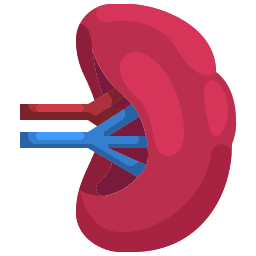AAST Spleen Trauma Grading & Score Calculator
References:
- Zarzaur, B. L., Kozar, R., Myers, J. G., Claridge, J. A., Scalea, T. M., Neideen, T. A., Maung, A. A., Alarcon, L., Corcos, A., Kerwin, A., & Coimbra, R. (2015). The splenic injury outcomes trial: An American Association for the Surgery of Trauma multi-institutional study. The journal of trauma and acute care surgery, 79(3), 335–342. https://doi.org/10.1097/TA.0000000000000782
- AAST (American Association for the Surgery of Trauma) 2018 guideline for splenic injury scoring.
- Organ injury scaling: spleen, liver, and kidney. Moore EE, Shackford SR, Pachter HL, McAninch JW, Browner BD, Champion HR, Flint LM, Gennarelli TA, Malangoni MA, Ramenofsky ML, Trafton PG. J Trauma. 1989 Dec;29(12):1664-6.
- Organ injury scaling: spleen and liver (1994 revision). Moore EE, Cogbill TH, Jurkovich GJ, Shackford SR, Malangoni MA, Champion HR. J Trauma. 1995 Mar;38(3):323-4.
Related Calculators:

More about AAST spleen trauma injury grading with this calculator:
Welcome to our comprehensive toolset designed to help healthcare professionals assess and grade liver, spleen, and kidney injuries based on imaging findings. Our calculators, built around the American Association for the Surgery of Trauma (AAST) guidelines, provide a systematic approach to evaluate the severity of organ injuries. Although these tools are independent and not endorsed by AAST, they are crafted to align closely with their established grading scales.
While the AAST Organ Injury Scales (OIS) encompasses a broad range of organs, including the liver, spleen, kidney, pancreas, vascular structures, and more, radiology-specific guidelines have primarily focused on the liver, spleen, and kidney. These radiology guidelines are integral in interpreting imaging findings to accurately grade injuries to these organs, thereby facilitating appropriate clinical decision-making.
AASTIt's important to note that the AAST's injury scoring scales extend beyond these three organs, covering a total of 32 different injury scores as of 2019. This comprehensive approach ensures that trauma care professionals have a standardized framework for assessing a wide array of injuries, promoting consistency and improving patient care across various clinical settings. By adhering to AAST guidelines, healthcare providers can ensure a systematic and effective approach to trauma management, leading to better patient outcomes and more efficient use of medical resources. The AAST's commitment to advancing trauma care through research, education, and the development of clinical protocols continues to be instrumental in shaping the field of trauma surgery.
Spleen Injury Grading Calculator
Purpose: To provide a detailed assessment of spleen injuries for trauma care using the AAST Spleen Injury Scale.
Grading Criteria (2018 Revision):
- Grade I: AIS Severity 2
- Subcapsular hematoma <10% surface area
- Parenchymal laceration <1 cm depth
- Capsular tear
- Grade II: AIS Severity 2
- Subcapsular hematoma 10-50% surface area; intraparenchymal hematoma <5 cm
- Parenchymal laceration 1-3 cm
- Grade III: AIS Severity 3
- Subcapsular hematoma >50% surface area; ruptured subcapsular or intraparenchymal hematoma ≥5 cm
- Parenchymal laceration >3 cm depth
- Grade IV: AIS Severity 4
- Parenchymal laceration involving segmental or hilar vessels producing >25% devascularization
- Grade V: AIS Severity 5
- Hilar vascular injury with devascularization of the spleen
- Shattered spleen
How to Use the Calculators
- Select the Organ: Choose whether you need to grade an injury to the liver, spleen, or kidney.
- Input Imaging Findings: Enter the details from the imaging studies, such as the extent of hematoma, depth of laceration, and presence of vascular injuries.
- Calculate the Grade: The calculator will process the input data according to the AAST guidelines and provide an injury grade.
- Clinical Application: Use the calculated grade to inform clinical decisions, guide management strategies, and facilitate communication within the trauma care team.
Important Notes
These calculators are independent tools and are not officially endorsed by the AAST. Always consider clinical context and other relevant factors when using these tools for patient care. Refer to the latest AAST guidelines and literature for detailed descriptions and updates on injury grading.




You’re wrong, the patient that I’ve demand to calcul the grade have laceration < 3cm and hematoma <5cm so I think grade 2 not 3
Hello Dr. Zoheir,
Thank you for your comment. Per AAST guidelines, if there are multiple injuries, grade should be upgraded to grade III.
Please note this line in the guidelines: “Advance one grade for multiple injuries up to grade III.”
Why does it now state that it’s grade 2 when I choose the same injuries?
Would you please try again and let me know if you still see a grade 2 with these injuries? On my end, the calculator shows a score of 3